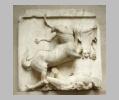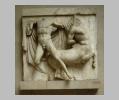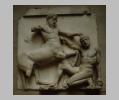
South Metope 6: Lapith and Centaur

South Metope 28: Lapith and Centaur

South Metope 27: Lapith and Centaur

South Metope 30: Lapith and Centaur

South Metope 32: Lapith and Centaur
| Collection: | London, British Museum and Athens, Acropolis Museum |
| Title: | Parthenon, Metopes |
| Context: | From Athens, Acropolis |
| Findspot: | Found at Athens, Acropolis |
| Summary: | Metope overview |
| Sculptor: | Literary attestation to Pheidias |
| Material: | Marble |
| Sculpture Type: | Architectural |
| Category: | Statuary group |
| Placement: | Exterior Doric frieze |
| Style: | High Classical |
| Original or Copy: | Original |
| Date: | 447 BC - 432 BC |
| Dimensions: | H 1.20 m, W ca. 1.25 m (W varies by ca. 0.15 m) |
| Scale: | Under life-size |
| Region: | Attica |
| Period: | High Classical |
Subject Description:
Each metope of the exterior Doric frieze of the Parthenon was carved with sculptural decoration. Each side of the building apparently had its own subject. Each subject depicted a battle. The general theme of each side is apparent, although the identification of the subject of specific metopes or groups of metopes is often debated. The general themes are identified as follows.
West: Greeks versus Orientals. Usually identified as an Amazonomachy, although Brommer reserves the possibility that the Easterners may be Persians. The extensive damage makes it difficult to determine the sex of the opponents. However, the bare limbs of at least one of these figures suggest Amazon rather than Persian dress, which usually includes long sleeves and leggings. The horses are also characteristic of an Amazonomachy. The three central metopes of the west are damaged beyond recognition. Nonetheless it is clear that each metope appears as a sculptural unit with no obvious relationship to the metopes on either side, other than the regular alteration of equestrian scenes with scenes of unmounted opponents. There is no clear narrative progression.
North: Greeks versus Trojans. Although the entire central section — more than half the side — is lost, related subjects at both ends framed by Helios rising and Nyx or Selene descending on her horse (a device also used in the East Pediment) suggest a single subject and a single time frame. The three westernmost metopes depict gods and goddesses, probably as "witnesses" of a sort as on the east frieze. Reading from left to right, the first metopes after Helios include men debarking from a ship and arming, apparently stages before the battle. Among the later, NM.24-25 show Menelaos pursuing Helen who has run to the Palladion for sanctuary. The identification is certain, for the scene was copied by a vase painter who inscribed the names of the figures. Since this scene takes place at the end of the battle, a sense of narrative progression is implied.
East: Gods versus Giants. Severe damage leaves individual identification difficult, but enough remains to determine the general theme and suggest specific identities. Each metope apparently includes at least one god. Their pronounced presence on the east side, i.e. the principal facade, is clearly intentional. There is a certain link here with the east frieze and east pediment. There is also a clearly planned progression of scenes compositionally, with the movement toward the center from each side, as in the east frieze. However there is no sense that one scene precedes another in narrative fashion. Despite the poor condition the symmetry of the overall design is clearly apparent and its original impression must have been even stronger. The composition of the fourth slab from each end is much fuller, and the charioteer next to each of these moves toward the center, focusing attention on the four central slabs. Whatever the significance here, Athena is not the focus. Her identification is reasonably clear owing to the presence of Nike beside her. She is off to one side (E.4), not particularly prominent within the design.
South: Centaurs versus Lapiths. By far the best preserved, even the missing slabs are known from the drawings of Carrey, who carefully recorded the entire side. All but the central nine (S.13-21) depict centaurs fighting men or, in a few cases, carrying off women. The central group, at least in part, is clearly set off from the battle. The problem, specific interpretation aside, is to what extent its subject relates to the fighting centaurs. The best known story of the Centauromachy involves the disruption of a wedding, and several interpretations offer a variation on this premise. The large number of women, their poses and attributes appear to support this. Some scholars see a specifically Attic myth represented. Robertson suggests that episodes in the life of Daedalus are depicted. Brommer believes that, whatever the subject, it relates directly to the centaurs so that the overall theme of the side is a unified one. The metopes involving centaurs appear, like those on the west side, to be individual units whose arrangement is not of great importance. The central metopes, however, suggest a definite relationship and order within the group.
Form & Style:
The variation in style is much greater among the metopes than in the frieze or pediment. Several explanations have been offered. One hypothesis, no longer much in favor, holds that some of the metopes are in fact significantly earlier because they were carved for an earlier version of the Parthenon never built. Other theories hold that, as the first of the sculpture to be assigned, they were not yet subject to a stylistic norm. Along related lines, the overall design may have been so general in nature that sculptors were left to their own devices for all but the loosest compositional guidelines. Whatever the reason, the diversity is greater on the south and west, which share a division by metopal unit and concentration of equine bodies as well. The most stylistically conservative of the metopes — some strikingly reflective of sculpture from the Temple of Zeus at Olympia — occur in this group as well, although there are also stylistically more advanced sections on the south. The north and east metopes appear more closely related to each other than to the west or south. They share a more carefully planned design and a richness of style. It may be significant that they occupy the more important and visible sides. Brommer finds the hand of at least one sculptor (N.29) also present in the west frieze, evidence of an overlap of work assignments among the different sculpted elements of the building. The great depth of the carving, which results in many figures sculpted nearly in the round, is also noteworthy. The overall design is generally attributed to Pheidias on the basis of his responsibility for the temple sculpture as a whole, although the degree to which the metopes reflects his style must remain entirely hypothetical.
Date Description:
Setting aside the hypothesis which attributes some of the south metopes to an earlier, unfinished temple, there is no hard evidence to suggest that any of the sculpture predates the earliest Parthenon building accounts of 447 B.C. The metopes were carved on the ground and then hoisted into position in the exterior Doric frieze. Construction required that they be in place before the pediments were erected or the roof put on. This need, together with the early style exhibited by some of the metopes, suggests they were the first of the sculptural elements begun. One can assume they were finished before the statue of the Parthenos was dedicated in the temple in 438 B.C., since by that time the roof was presumably done and all supporting architectural members in place. The metopes can thus be reasonably dated to the years 447-438 B.C.
Condition: Fragmentary
Condition Description:
East and West: all slabs preserved but heavily damaged. North: 13 slabs preserved, all but NM.32 badly damaged. E, W, N metopes in Athens. South: Well preserved and/or known through Carrey drawings of 1674. 18 slabs extant. SM.2-9 and SM.26-32 in London, SM.10 in Paris, SM.1 and SM.12 in Athens.
Material Description:
Pentelic Marble
Associated Building: Athens, Parthenon
Sources Used:
Other Bibliography:
